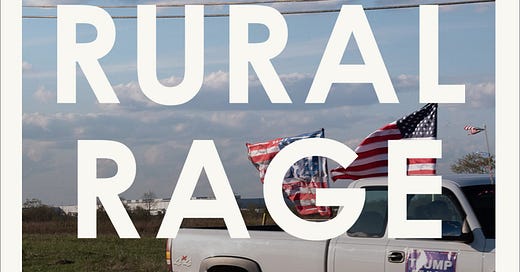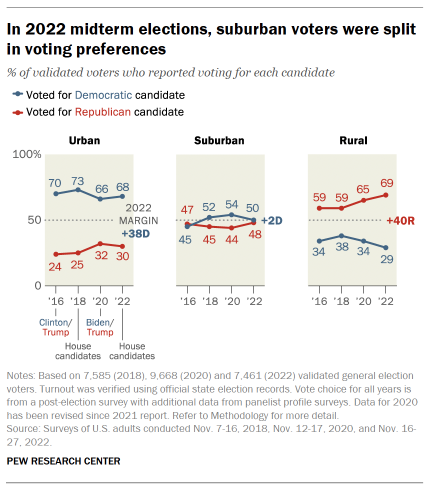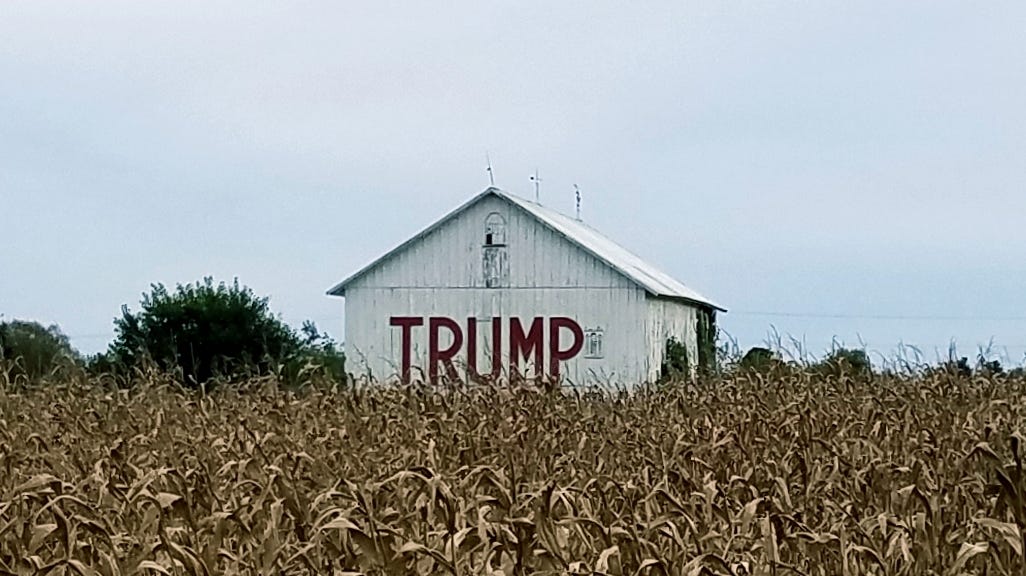If Donald Trump gets back to the Oval Office, it will be because — once again — rural Whites put him there. Which is why I hope that White Rural Rage: The Threat to American Democracy, my new book with Tom Schaller, will be particularly timely as we head into the general election.
The book is finally on sale (today!), so I thought I would give a brief preview of what it argues and how we approached this subject.
Why we wrote this book
Tom and I have been friends and collaborators since we began working together on The Gadflyer, a web magazine from blogging’s Golden Age (i.e. the George W. Bush presidency). After January 6, we began talking more and more about the rural voters that are at the core of Donald Trump’s support, and as we considered the topic, the more a particular contradiction came into focus: Though the news media are intensely interested in both Trump’s base and the fragility of American democracy, they’ve been reluctant to draw the connection between the two.
Doing so requires speaking honestly about the disturbing undercurrents of opinion and action one finds within that base, in particular, conservative White rural voters. The more we looked into patterns of public opinion, the more it became clear that rural Whites are more likely than other Americans to express racism and xenophobia; to fall prey to conspiracy theories; to have the thinnest commitment to foundational democratic principles; and in extreme cases, to support violence as a political tool.
While those kinds of beliefs can be found everywhere, if they are particularly prevalent among rural Whites, America has a serious problem on its hands. That’s because while rural Whites are treated with kid gloves — and often lauded as the realest of “real” Americans — they also wield outsize power in our political system. Not only are they given added political leverage by the Electoral College and the anti-democratic design of the U.S. Senate, in state after state, Republicans have built their own power on drawing district lines to maximize the electoral influence of rural Whites.
There are urban-rural tensions everywhere in the world, and they’ve existed as long as there have been cities. But America is unique in some vital ways. Only here are rural citizens given this kind of elevated status, their influence magnified by the way we apportion voting power at both the federal and state level. And only here is the far-right party that builds its power on rural citizens not a secondary or fringe party, but one of the two parties that contends every election.
That brings us to another contradiction we explore in the book. The hold of the Republican Party on rural areas has grown stronger and stronger; as Mitch McConnell once said, “We pretty much own rural and small-town America.” Take a look at these data from the Pew Research Center’s validated voter studies, which are pretty much the most accurate polls of voters you can find (they’re far superior to exit polls). Note the graph on the right:
Keep in mind, those figures include all rural Americans, including the quarter or so of rural people who aren’t White. If you separated out just rural Whites, the figures are higher; according to Pew’s data, Trump got support from 62 percent of rural Whites in 2016 and 71 percent of rural Whites in 2020. (This raises another question that is almost never asked: What about the non-White people who live in rural America? We have a whole chapter on that subject.)
Well, you might say, that’s Trump: They love him in rural America. Indeed they do. That’s a subject we explore as well: Why? After all, we’re always told that if a candidate wants to get support from rural voters, he’ll have to show up, listen, treat them with respect, and show them that he truly understands their lives. He’ll have to visit farms, talk commodity prices, maybe milk a cow. But Trump did none of those things. And yet they don’t just like him, they positively worship him.
In fact, if you look at the counties where Trump performed best, they’re almost all rural. And in 91 of his top 100 counties, he gained votes between 2016 and 2020, even though he did nothing to address the deep problems from which rural America suffers.
That’s another part of the story we tell — not just why rural people love Trump, but the way they keep giving their votes, in ever-increasing numbers, to Republican politicians who do virtually nothing to improve their lives and help their communities.
How we wrote this book
There were many approaches we could have taken to this project, all of which have their virtues. There are terrific books about rural America that are primarily memoir; I’d recommend Sarah Smarsh’s Heartland or Monica Potts’ The Forgotten Girls if that’s something you’re interested in. There are also great books by academics exploring issues of rural-urban conflict from a 30,000-foot view; my favorite of these is probably Jonathan Rodden’s Why Cities Lose. There are also excellent books in which a journalist or academic immersed themselves in a single place for an extended period of time, like Arlie Hochschild’s Strangers in Their Own Land.
All of those methods are worthwhile, but we decided to take a hybrid approach to this subject. We examined voting patterns and public opinion data to get that 30,000-foot view. We interviewed experts and political actors to get their interpretations of recent developments. And we traveled to a variety of rural places around the country to report on how politics is playing out on the ground.
The picture that emerges is deeply troubling in many ways, but in the end we point a way forward that starts with rural people demanding more of the Republicans they keep electing, and runs through the creation of a multiracial rural movement, one that must not be driven by a rejection of our foundational democratic principles. But before that happens, we have to acknowledge the pernicious role our rural White brothers and sisters are playing in putting our democracy on a knife’s edge.
If you want to check out the book — and maybe buy a few dozen copies to give out as gifts! — here are some places you can go:







This is just more of the "clinging Bibles" and/or "deplorable" narrative being promulgated by people who have little to no interaction with rural communities.
As discussed in this old blog, https://lachefnet.wordpress.com/2021/01/13/a-belated-response-to-philpotts-racist-roots/ like other forms of prejudice, this narrative is based on preconceptions and stereotypes of one group of people made by another group that has made no real effort to understand anyone who isn't part of their own tribe or group.
I think you pander and spread lies. I live in a small village mostly white but people here would gladly have more diversity. It is too far from the city center and there are few houses that come up for sale. I used to believe like you but I was married for 20 years to a black man and grew up in the 50’s. I know what racism is and I live in the rural part of the country and there is no rage against people of color. Stupid polices, yes. You try to demean half of our fellow citizens to create division. Get out and your bubble and see the world as it really is. I did and I will never again waste time on books like yours and never again, after a lifetime as a democratic voter, will ever vote democrat again.